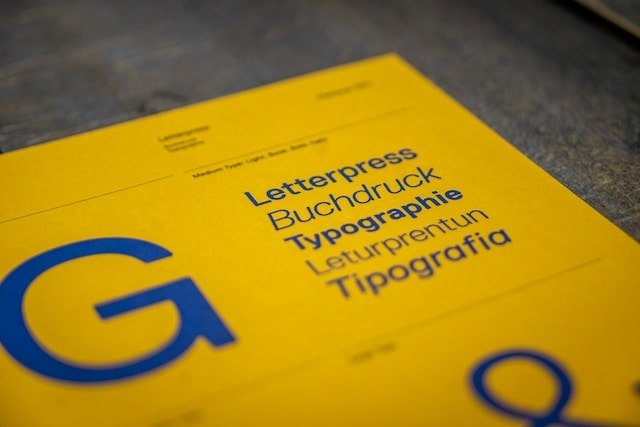I. Introduction
In a world increasingly dominated by visual content, graphic design skills have become an essential part of many industries, and learning these skills has never been easier with the right resources and tutorials at your fingertips. This article provides a list of some of the best graphic design tutorials for beginners that can help you master design quickly.

II. The Importance of Learning Graphic Design
Before we delve into the best graphic design tutorials for beginners, let’s first understand the significance and benefits of learning graphic design. Graphic design is much more than making something look appealing; it’s a way of communication, solving problems, and enhancing functionality through visual means.
A. Role of Graphic Design in Today’s World
Graphic design plays an integral role in virtually every sector today, from business and marketing to entertainment and education. It’s the driving force behind creating compelling and effective visuals that convey messages, provoke emotions, and lead to actions.

In the business world, graphic design can aid in establishing a strong brand identity. It’s a key component of creating a memorable logo, attractive packaging, and effective advertising campaigns. Moreover, with the increasing importance of online presence, graphic design is essential for creating a user-friendly and visually pleasing website or mobile app, improving user experience and engagement.

In the field of education, graphic design can help in developing effective learning materials, making complex information more understandable and appealing. Similarly, in entertainment, graphic design is at the heart of movie posters, album covers, book covers, and more, often being the first thing that catches the viewer’s or reader’s attention.
B. Career Opportunities in Graphic Design
With growing demand, graphic design offers a wide array of career paths to explore. From being a freelance designer and working in an agency to branching out into digital media, the opportunities are endless.
As a graphic designer, you can work in various fields like advertising, publishing, public relations, etc. You could be creating logos and branding materials as a brand identity designer, developing user interfaces and experiences as a UI/UX designer, or creating motion graphics for digital and television networks as a motion designer.

The possibility of working as a freelance designer also opens doors to working with various clients on diverse projects, which can offer great learning opportunities and flexibility. Furthermore, with the growth of digital media, fields like social media design, web design, and mobile app design have seen a surge in demand for graphic designers.
Therefore, learning graphic design can be a stepping stone to various rewarding career paths, making it a valuable skill to acquire.
III. Key Elements of Graphic Design for Beginners
If you’re new to graphic design, understanding its fundamental elements can serve as a solid foundation for your learning journey. These core principles and components will guide you as you explore the realm of design and develop your unique style.
A. Typography
Typography is the art of arranging type to make written language legible and visually appealing to the reader. It’s an essential aspect of graphic design, often having a significant impact on the overall aesthetics and readability of a design.

Typography involves understanding and applying different typefaces or fonts, setting the appropriate line-height, and adjusting kerning and tracking for optimal readability. There’s also the crucial task of choosing the right typeface to set the right tone and evoke the desired emotion for your design. From logo designs to website content and advertising materials, typography can often be the difference between a design that sings and one that feels flat.
B. Color Theory
Color theory is a vital part of graphic design that deals with how colors interact, the emotions they evoke, and how they can be used effectively in design. It involves understanding the color wheel, color harmony, and the psychological implications of different colors.

The color wheel serves as a visual representation of colors arranged according to their chromatic relationship. Primary, secondary, and tertiary colors are fundamental aspects of color theory, and understanding them can help you create a harmonious color palette for your designs. Furthermore, different colors can stimulate different emotions, meaning that your color choices can significantly influence how your design is perceived.
C. Layout and Composition
Layout and composition refer to how elements are organized in a design. They guide the viewer’s eye and create a flow that makes the design easy to understand and engage with. The effective use of space, alignment of elements, and maintaining a balance between different parts of the design are all part of layout and composition.
The principles of layout and composition, such as the rule of thirds, balance, alignment, contrast, proximity, repetition, and white space, are fundamental to creating effective designs. Whether you’re designing a website, a poster, or a business card, understanding and applying these principles will help you create designs that are visually appealing and effective in conveying the intended message.
IV. Top 7 Graphic Design Tutorials for Beginners
There are countless graphic design tutorials available online, but not all of them are suitable for beginners or provide comprehensive, easy-to-follow content. Here, we’ve compiled seven of the best graphic design tutorials, both free and paid, to help kickstart your journey in mastering design.
A. Canva Design School (Free)
Canva Design School offers a series of free tutorials covering everything from the basics of design to more advanced topics. You can learn about color theory, typography, branding, and more. Each lesson is accompanied by practical tasks, allowing you to apply what you’ve learned immediately.

B. Adobe Photoshop Tutorials (Free & Paid)
Adobe’s own tutorials for Photoshop provide an extensive range of lessons suitable for beginners. They cover basic tools, photo editing, creating complex designs, and more. The free tutorials offer a great starting point, while the paid ones delve deeper into advanced techniques.

C. LinkedIn Learning – Graphic Design Basics (Paid)
Graphic Design Basics by LinkedIn Learning covers core principles like alignment, proximity, contrast, and repetition. With real-world examples and practical exercises, you can develop a strong foundation in graphic design principles.

D. Coursera – Graphic Design Specialization (Paid)
This online course by CalArts, available on Coursera, is an excellent comprehensive guide for beginners. It covers fundamental skills in graphic design, including typography, image-making, and composition.

E. Skillshare – Graphic Design Basics: Core Principles for Visual Design (Paid)
This course by Ellen Lupton and Jennifer Cole Phillips dives into five fundamental principles of graphic design. It’s an excellent course for beginners seeking a well-rounded understanding of graphic design.

F. Udemy – Graphic Design Bootcamp (Paid)
Derrick Mitchell’s course on Udemy is designed for people new to the world of graphic design. The course covers Adobe’s primary design tools: Photoshop, Illustrator, and InDesign, and provides practical projects to apply your learning.

G. YouTube – Bring Your Own Laptop (Free) – Recommended
The YouTube channel “Bring Your Own Laptop” is an invaluable resource for any aspiring graphic designer. Run by Daniel Scott, an Adobe Certified Trainer, this channel offers easy-to-follow video tutorials on various graphic design topics. The content includes detailed guides on how to use tools like Adobe Photoshop, Illustrator, and InDesign. From basics to advanced techniques, these tutorials provide practical, hands-on learning for graphic design beginners.

V. Tips and Strategies for Effective Learning
As a beginner delving into graphic design, you’re stepping into a world of creativity, where concepts, colors, and typography combine to tell a story or convey a message. Here are some strategies and tips to streamline your learning journey, enabling you to master the art of graphic design more effectively.
A. Prioritize Hands-On Learning
In graphic design, theory alone isn’t enough; you must practice applying what you’ve learned. Use the tools and techniques you learn from tutorials on real projects, even if they’re just for practice. The hands-on experience will reinforce your understanding and help you develop your unique style.
B. Don’t Rush; Start with the Basics
Begin by understanding the fundamental principles of design, like alignment, balance, contrast, and hierarchy. Get comfortable with the basic tools and functionalities of design software before moving on to more complex tasks. Remember, solid houses are built on solid foundations.
C. Find a Learning Community
Whether online or offline, a community of learners can offer immense support. You can share your work, get feedback, exchange ideas, and learn from others’ experiences. Platforms like Reddit, Behance, and Dribbble host vibrant communities of graphic designers.

D. Keep Up with Industry Trends
Graphic design trends evolve rapidly. Staying updated can help you create designs that are contemporary and relevant. Following industry leaders, subscribing to design blogs, and attending webinars or workshops can help you stay abreast of the latest trends and technologies.
E. Leverage Online Resources
Apart from structured tutorials and courses, a plethora of online resources can supplement your learning. Websites like Pinterest can provide design inspiration, while YouTube tutorials can offer quick solutions to specific problems.
F. Build a Portfolio
A portfolio showcases your skills and progress. Start building your portfolio early, updating it with your best work as you learn and improve. It will serve as a tangible record of your learning journey, and it can also be a great tool for receiving feedback.
G. Don’t Fear Critique
Constructive criticism is a powerful tool for growth. Share your work with others and be open to their feedback. Different perspectives can offer invaluable insights and highlight areas for improvement.
H. Explore Various Design Discipline
Graphic design encompasses various disciplines, from print and digital design to animation and UI/UX design. Exploring different disciplines can broaden your skillset and open up new avenues of creativity.
I. Take Breaks
While consistent practice is crucial, so are breaks. Overworking can lead to burnout and stifle creativity. Regular breaks can help maintain your enthusiasm and provide fresh perspectives.
J. Develop a Habit of Observing
Observe the designs in your daily life—billboards, packaging, websites, apps, posters. Analyze what works and what doesn’t in these designs. This habit will enhance your understanding of practical design and help improve your skills.
VI. Final Thoughts on Graphic Design Learning Journey
Embarking on a journey to learn graphic design can be both challenging and exhilarating, but with these top tutorials and the right mindset, you can master design swiftly and efficiently. Remember, patience, persistence, and practice are key in this creative journey.
Frequently Asked Questions
Q1: Are these graphic design tutorials suitable for complete beginners?
A1: Yes, the tutorials mentioned in this article are carefully selected to cater to beginners who are just starting their graphic design journey.
Q2: Can I learn graphic design without going to a design school?
A2: Absolutely, with the wealth of online resources available today, you can learn and master graphic design at your own pace and convenience without the need for formal education.
Q3: What are the best free graphic design software tools for beginners?
A3: Some of the best free graphic design software for beginners include tools like Canva, GIMP, Inkscape, and Gravit Designer.
Q4: How long will it take for me to become proficient in graphic design?
A4: The time it takes to become proficient in graphic design varies depending on the individual. It could take anywhere from a few months to a couple of years, depending on your commitment and how much time you dedicate to learning and practicing.
Q5: What are other resources I can use to learn graphic design?
A5: In addition to online tutorials, you can learn graphic design through books, online courses, design blogs, and by following renowned designers on social media platforms.



























































